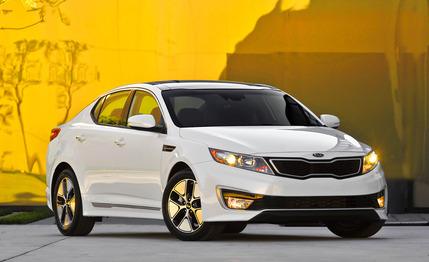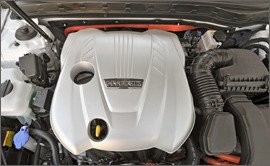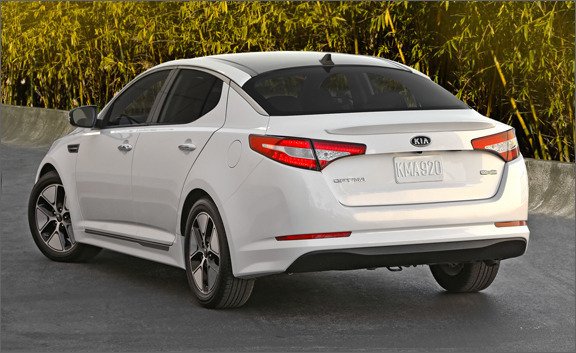 First Drive Review
First Drive Review
What Is It?
The Hyundai Sonata hybrid wrapped in the Kia Optima’s burlier skin. Like the gas-electric Sonata, the Optima is powered by a 166-hp, 2.4-liter four-cylinder engine mated to a 40-hp electric motor. Total output is 206 hp and 195 lb-ft of torque, which is sent to the front wheels via a six-speed automatic transmission. Although the EPA hasn’t officially rated the Optima hybrid, it should get the same 35 mpg city/40 highway projections as the Sonata.
On the outside, the hybrid looks like most other Optimas, although close inspection reveals numerous aero-related enhancements including flat-faced 16-inch wheels, rocker-panel extensions, a unique grille, revised bumpers, and new head- and taillight lenses. Inside, base Optima hybrids come equipped with power fabric seats and a leather-wrapped steering wheel, as well as pushbutton start and dual-zone climate controls. Kia’s voice-activated, Microsoft-developed UVO infotainment and communications system is now officially available in the Optima hybrid, but when customers spring for the $5000 Hybrid Premium Technology package, UVO gets bumped in favor of a touchscreen navigation system. That bundle also has an eight-speaker Infinity sound system, a backup camera, leather seats, a panoramic sunroof, 17-inch wheels, HID headlamps, and other sundry items.
How Does It Drive?
A slight delay before the gas engine is summoned slows the Optima hybrid off the line. The gas pedal might make suggestions to the powertrain, but it doesn’t seem to get much respect. During our brief test drive, we sometimes heard engine revs surge and dip erratically, although acceleration remained constant. At other times, pedal requests were answered with a bit more power or somewhat less than we expected. Smooth stopping requires careful attention, too, as the brakes are tasked with reenergizing the lithium-polymer battery pack. These tendencies are common among hybrids but are a bit more pronounced in the Optima than in most others. They served to remind us of how many powertrain decisions are made by computers and how few are made by the driver.

Fortunately, in most other respects, the hybrid behaves like a naturally aspirated Optima. The steering is quick, weighty, and precise, the ride taut but not brittle. The interior features the same attractive, comfortable seats and swank décor as in other Optimas, but certain elements in the hybrid-specific instrument display—such as the bar-graph-style tachometer—are way too small. One significant demerit: The hybrid’s trunk volume is down by more than a third, to just 9.9 cubic feet.
How Does It Stack Up?
Other than the Sonata, the Ford Fusion hybrid is the Optima hybrid’s closest competitor. The Optima lags well behind the Fusion’s powertrain refinement, although its design makes the Ford—and everything else in the segment save the Hyundai—look frumpy and old. The Optima’s probable EPA projections of 35 mpg city/40 highway, meanwhile, transpose the Ford’s 41/36. Next to the Nissan Altima (33/33) and Toyota Camry hybrids (31/35), the Korean twins have a pronounced edge in efficiency, although the American entry’s hybrid system is by far the best in the class.
What’s the Cost?
At $27,250, the Optima hybrid costs about $700 more than the hybrid Sonata, and it undercuts the Altima and Camry hybrids by a few hundred bucks. Compared with the Fusion hybrid, the Optima boasts a price advantage of more than $1900. Also significant is that the Optima hybrid and its Hyundai-branded sibling are the only ones in this group backed by a 10-year powertrain warranty.
All the parts of this car that are regular Optima are satisfying, but the purpose of a hybrid is, well, that it’s a hybrid. Until the powertrain woes are sorted, that more expensive Fusion is going to look like the far better choice in this segment.
